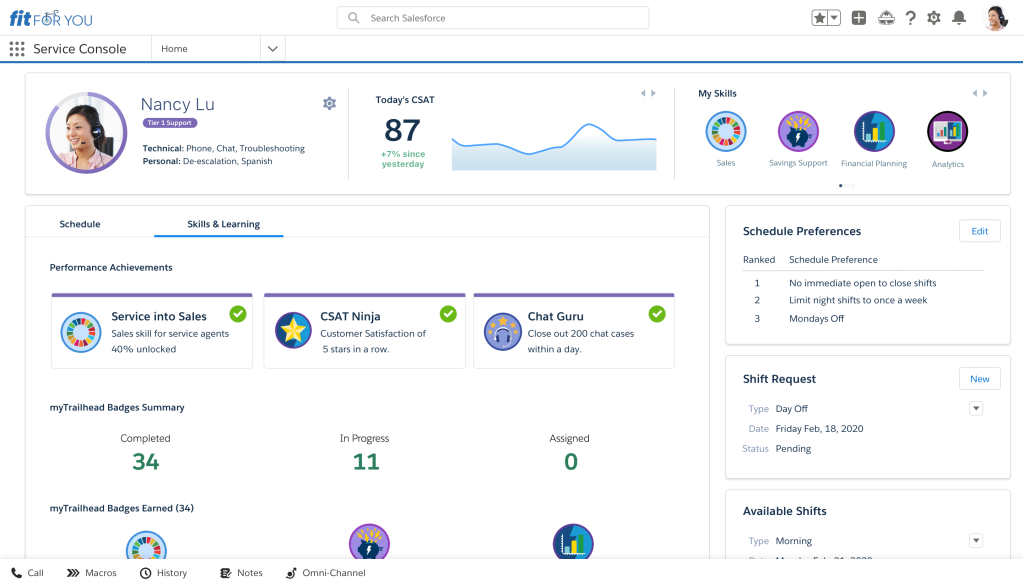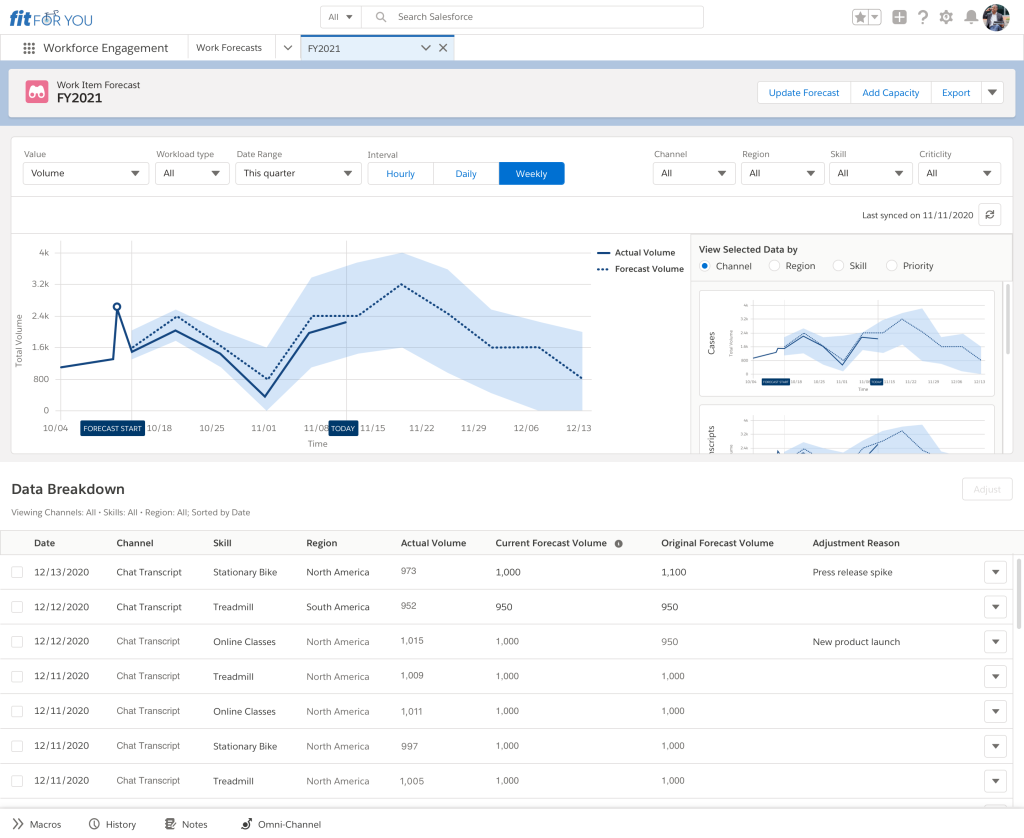As consumer behavior and expectations continue to shift and become more complex with the COVID-19 pandemic, Salesforce’s role in the customer service industry is also evolving. Today Salesforce announced a new Workforce Engagement product built to help service leaders in the contact center ensure they have the right agents with the right skills staffed at the right time. We sat down with Melissa Matross, SVP of Product Management, to learn more about the importance of Service Cloud Workforce Engagement and how this new product will make service teams’ jobs easier, while optimizing processes to meet any influx of customer service demand.
Q: What is Workforce Management and how has the industry evolved?
Workforce management as an industry has been around for over 30 years and historically, it has been all about operational efficiency — making sure that service centers have just the right number of people with the right capabilities to meet customer demand. It was very machine-oriented, and service agents were essentially viewed as cogs in that machine.
Since then, two major things have happened. First, service centers have evolved and become much more operationally complex. For example, more channels have been introduced, which makes forecasting and planning much more complicated and difficult to navigate. Back in the day, it used to be that every agent was on one call at a time, and it was only on that one channel (phone) that a customer was reaching out. Now, with the advent of other channels like chat and text, an agent can handle multiple customer inquiries at once. So a question that businesses are asking themselves is, “How can we manage our service team staffing needs, while we have agents working across a variety of different channels at a moment’s notice?”
Automation has had a direct impact on the agent’s quality of life — in a positive way.”
Melissa Matross, Senior Vice-President Product Management, Salesforce
Secondly, AI and automation have become key factors in service optimization, scheduling and planning — and that’s really where the engagement piece comes into play. Automation has had a direct impact on the agent’s quality of life — in a positive way.
Q: Why does good customer service matter today?
Building a service center fully equipped to meet today’s demands has never been more critical, especially as we continue to battle through the COVID-19 pandemic. Today’s service agent is required to be able to engage on more platforms and touchpoints than ever before – checking email, text messages, scrolling a Twitter or Facebook feed, etc. Further, they’re expected to pull customer data from more sources, log more detailed service transactions, be proactive in customer service outreach, and more — all to keep up with an ever-growing demand for fast and quality customer service.
When it comes to existing Workforce Management solutions, there’s a crucial element of “engagement” that is often missing.”
Melissa Matross, Senior Vice-President Product Management, Salesforce
Last month, I found myself in a Starbucks parking lot frantically waving my phone in the air, desperate for a WiFi signal. I had moved to a new home the previous week, and with my internet not yet set up, I had to hit the road to do my job. It took five customer service calls, three trips from a technician, and an in-store visit before my WiFi was functioning. The experience was a glaring reminder of how much more the service industry could do to create a better experience for customers — and why it’s so important that we get it right. At Salesforce we understand the pressure on service teams, and we’re dedicated to helping our customers provide great service to their customers.
When it comes to existing Workforce Management solutions, there’s a crucial element of “engagement” that is often missing. Engagement that frees service professionals from mundane manual tasks and allows them to focus on what matters the most — delivering exceptional customer service.
Q: Can you elaborate on the importance of “engagement?”
Of course. Engagement in the context of the workplace falls into a few different categories. One is an effort to develop employees that want to do their jobs successfully and help drive great outcomes for customers. Essentially, at its core, an engaged employee is one who is motivated to deliver great service and support the company mission.

In today’s new distributed way of working, engagement is driven by several different factors and considerations. Employees are asking themselves, “Am I learning? Am I growing? Do I have a career path here?” Engaged employees are always learning and growing, and typically have a clear vision for what they perceive as their desired career path, which they might not have had before engagement became a priority.
Secondly, engagement in a distributed workforce means enabling agents to ask questions and get support within their own teams. Our Workforce Engagement capabilities provide the proper tooling to help service agents get the information they need and collaborate with peers, effectively creating an environment that allows them to be successful. Engagement is having ownership, empowerment, collaboration, and an individualized career path at one’s own fingertips. This is why we decided to name our product Workforce Engagement; it’s more than just Workforce Management.
Q: How have service skills evolved today?
As capabilities for service professionals have become increasingly complex, the expectations for what agents have to be educated on and able to do have evolved as well. As automation handles the simpler customer service tasks, service professionals find themselves addressing more complicated cases on a regular basis. This means there are several additional skills that an agent needs to acquire. So now, not only do agents need to handle customer inquiries on a variety of channels, they also have to develop interpersonal skills that allow them to address these more complex cases.
The role of the service center is shifting from being a cost center to a profit center.”
Melissa Matross, Senior Vice-President Product Management, Salesforce
Specifically, soft skills and empathy are necessary for each customer service interaction. Usually when a customer contacts a service department, they have a problem that needs to be addressed. This, paired with the fact that we are in unprecedented times as a society means customers are looking for more than just a simple one-and-done interaction. They’re looking for understanding and appreciation for their needs as a customer, and to feel valued and prioritized — no matter how big or small their inquiry might be.

The role of the service center is shifting from being a cost center to a profit center. A customer service department is not only the face of the brand and the first line of communication with existing customers, it’s an opportunity for brands to build life-long loyalty through investment in consumer trust and genuine care. Ultimately, service agents don’t only need to stay up-to-speed on where to communicate with customers, they need to understand how to best communicate with them in a human way.
Q: On the business end, what are the benefits of empowering service teams with Workforce Engagement?
Current workforce management solutions are inefficient. In fact a majority (83%) of workforce planners are using spreadsheets in some capacity — even if they have also implemented a workforce planning tool. These teams spend a ton of time loading and cleaning data sets so that they can be useful. Not only does this take time, but it also makes service teams less dynamic. Because of these inefficiencies, they can’t respond as quickly to changing demands.
Secondly, contact centers typically have several different tools to manage their workforce operations and optimize their teams, each with a different function. They have the CRM solution, where they can see a customer’s information at the beginning of an interaction. Then, separately there are routing solutions that calibrate based on scale, schedule or availability. What you have is a number of disparate, on-premise solutions that are not communicating with each other — leading to operational inefficiency and confusion.
With Service Cloud Workforce Engagement, we’re providing service teams with a cloud-based, connected solution — all on one platform. We are now able to connect all these disparate systems, making it much more seamless to manage — as well as making the data flow more streamlined.

Workforce Engagement also helps minimize any risk of manual error — not only by removing the manual input, but also with constant monitoring and outlier detection. If there is something in the historical data that might be compromising the accuracy of a team’s forecasting, we flag it directly to them — rather than having them sift through and find the anomaly themselves.
There’s a significant lack of visibility right now, specifically as we navigate this pandemic and as service teams remain distributed. Historically, contact centers have had fairly strong management oversight — but that layer is now lost given the move to remote work. Gaining visibility into what’s happening on a moment by moment basis is much more challenging. Service Cloud Workforce Engagement is helping alleviate the stress of this change — not only allowing service agents to focus on delivering an exceptional trusted service, but eliminating age-old inefficiencies along the way.
















